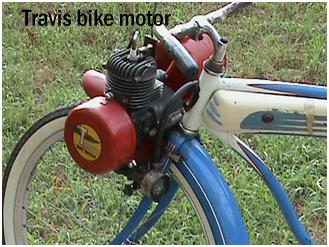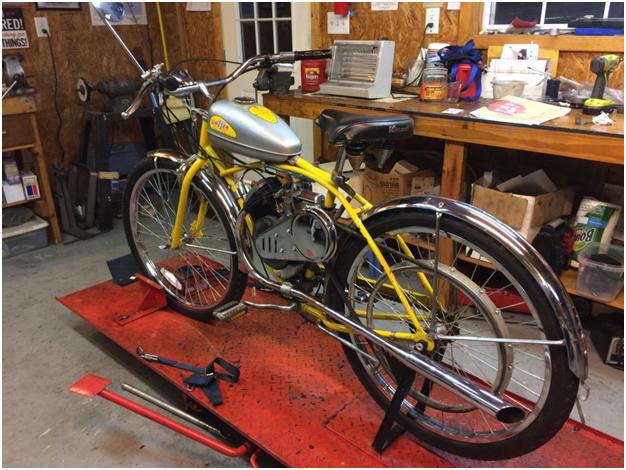|
|
My Whizzer Motorbike |
|
|
|
My Whizzer Motorbike |
|
1952, North Judson Indiana: I was 8 years old and my best friend at the time was Mike Thomas who lived a few blocks away. All summer long we would play on the sand hill behind his house or ride our bicycles out to the Bogus ditch where we would swim or fish. Mike had two older brothers Richie and Robert. This day, however, Mike’s father rounded up his 3 sons and me and packed us all in his car. He said we were going to Toto, a small village about 10 miles away. Toto was sort of in the middle of nowhere but people went there because the Weinburg bothers had a big discount store there that sold just about everything you could imagine at really good prices. Because the Weinburg’s business was obtaining odd lots of close-out merchandise in Chicago and bring them to Toto to sell, you never would know what would be on sale on any given day. Mike’s father had learned that they had just obtained a couple Whizzer motorbikes. I will never forget that moment we first laid eyes on them. For me at least it was love at first sight. The red and chrome machines were the most beautiful things I had ever seen. It was at that moment that my life-long romance with motor cycles began. Mike’s dad was pleased with the prices and promptly bought both of them, one for Richie and one for Robert.
There were other bicycle motors available in those days. The Travis was the most common. There were ads for them in the back of Popular Mechanics. It attached to the front forks and replaced the front fender (see picture). Its little 2 cycle motor turned a roller that pressed against the front tire. The rider was always enveloped in a cloud of 2 cycle smoke and if you were lucky enough to get it to start it would wear the tread off a tire in about 10 miles. I remember getting one in a trade when I was in high school. I got rid of it after it ruined my tire. The thing about a Whizzer is that it looked like a motorcycle! The purpose-built motor filled the void in the bicycles frame perfectly. And they were tough. I don’t remember either of those 2 Whizzers ever having a mechanical problem. They just ran and ran. They survived all of the abuse that teenage boys could dish out.

Robert and Richie rode them for years and when Mike was old enough to ride he inherited Robert's and he rode it. Mike and I gradually drifted apart as we made other friends. At age 14 I started riding Cushman scooters and at 16 I got a Harley Hummer which started my motorcycling in earnest. Every now and then, however, I would catch a glimpse of Mike riding past my house on that gorgeous Whizzer. It was sort of a first love that I never got over. I have owned many bikes over my 58 years of riding but I never found a Whizzer.
Most Whizzers were sold as a kit that one would attach to a regular bicycle. The kit included a motor, gas tank, exhaust pipe, handlebar controls, v belts, and a big pulley that attached to the rear wheel. However, they also made some ready-to-ride models. the most popular one used a Schwinn Phantom bicycle. The picture below is of a Pacemaker with a model J engine like those that Richie and Robert had. They had a 140 cc flathead motor making 3 hp motor and a twist grip throttle. 3 hp doesn’t sound like much but it does not take much power to move a bicycle. They had a clutch lever on the left bar and that controlled a single speed transmission. The rear coaster brake on a Schwinn bike was not quite enough to stop a 40 mph bicycle so the ready-to-ride models also had a small drum brake on the front wheel. The Phantom’s springer fork helped smooth out the bumps. The motors had good torque and despite the single-speed transmission they would pull away from a stop with no trouble thanks to a little slip from the V belts. You started it by pedaling while holding the compression release lever in to get the motor spinning. When you let go of the compression release the motor would come to life. The clutch allowed you to keep the motor running at stop signs.

Fast forward to 2017. I have a neighbor who has a small motorcycle and scooter collection and he acquired a Whizzer several years ago. I helped him get it running but it never ran well and the belts slipped horribly. It needed lots of TLC. So it sat in his shop neglected. Recently he bought a rough Triumph T140 Bonneville that supposedly ran when it was parked many years ago. He said that if I could get the Triumph running I could have the Whizzer. We agreed that he would pay for any parts it needs and I would get the Whizzer for my labor. Both brakes were full of rusty hydraulic fluid with frozen calipers and plugged lines. The wiring was a bird’s nest of spliced and cut wires with crimp connectors everywhere. it had to be extensively rewired. The carburetors, exhaust, and air box were all in a cardboard box with lots of missing hardware and rust. There was water in the primary and the clutch plates were rusted together. The entire primary had to be taken apart, cleaned, and reassembled properly. After about 5 full days of work I had it together, looking good, and running. In return I became the owner of my long sought after Whizzer. It was a 1949 model 300 motor in a later model yellow Schwinn 26” bicycle.
The first order of business was to disassemble the carburetor and soak the parts in carb cleaner. The float bowl was full of Alabama red clay which accounted for the poor engine performance. The second task was to sort out the cables. The throttle was frozen and the compression release was too stiff to use. The clutch lever was something off a lawnmower. I made a new compression release cable out of regular motorcycle grade cable and housing. The throttle cable and twist grip came apart and were thoroughly cleaned and lubricated. After that the twist grip worked freely. I replaced the lawnmower clutch lever with an Amal clutch lever from a Triumph motorcycle. That gave good clutch action. The factory Whizzer had a small drum brake on the front wheel along with a sprung fork (see the above picture). This one just had the ridged fork with no brake. However, a previous owner had mounted a caliper brake which rubbed the rim on the front wheel. I made up a cable for it and mounted an Amal brake lever on the left bar so I had a front brake. The petcock on the tank leaked but I found a replacement just like the original at a local lawn mower shop. After an oil change I fired up the motor and it ran fine with no smoke.
On my first test ride I discovered it had no rear brakes. When I tried to take the rear wheel off I found that to be a daunting task. Normally to take a wheel off a bicycle you turn it upside down but you can’t do that with a tank full of gas. The bike has a center stand but it comes off with the rear wheel. Also, the rear wheel not only has a chain attached to it but it also has a fan belt which further complicates the job. I finally hung the bike from a hook in the ceiling with some rope tied to the seat and with much struggling got the wheel off. The coaster brake has two little steel brake shoes that rub on the inside of the hub. I They are supposed to be dry but these had been packed with grease. A trip to the parts washer cleaned off the grease and with the help of a friend I got the rear wheel back on without too much cursing. After some spit and polish I soon had it looking good with a just enough patina to look its age.

A lovely trip around the neighborhood was my reward. It is amazing how well the 3 hp Whizzer engine powers the bike. Just putting along at 15-20 mph is a real pleasure. Up the hills down the hills around the corners the Whizzer is as great a ride just as I dreamed it would be. The exhaust has a “nice put put put” sound but twist the throttle and it will go faster than any bicycle should. Finally, after all of these years I have my beloved Whizzer.

Here is a close up of the engine. The side draft carburetor has a fine fiber air cleaner that can be cleaned and reused. Note the clamps that hold the motor in the frame. The big pulley on the rear wheel is held on with special bolts that clamp on to the spokes. The little plate below the air filter houses the ignition points. The cable behind the seat post is the clutch cable. It pulls the double pulley on the other side of the bike down against the big spring to loosens the belts.